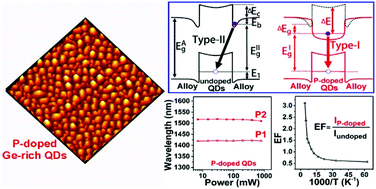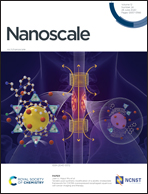Promising modulation of self-assembled Ge-rich QDs by ultra-heavy phosphorus doping†
Abstract
Self-assembled Ge-rich quantum dots (QDs) can not only act as a prototype model for the fundamental studies of heteroepitaxial growth but also have great potential in optoelectronic devices for telecommunication and monolithic optical-electronic integrated circuits. Here, we report the unique features of Ge-rich QDs ultra-heavily doped with phosphorus (P) and embedded in a thin SiGe alloy film on Si (001) substrates. The ultra-heavy P doping considerably reduces the size of Ge-rich QDs and improves their uniformity. The inherent mechanism is associated with the reductions of both surface energy and the diffusion length of adatoms during QD growth promoted by the P dopants. Raman spectra indicate that the Ge content and strain in QDs are essentially not modified by the P doping. Particularly, the power- and temperature-dependent photoluminescence (PL) spectra demonstrate a type-I band alignment of Ge-rich QDs/SiGe alloy film due to the ultra-heavy P doping, which gives rise to additional low energy levels of electrons in QDs. Moreover, the PL of Ge-rich QDs is remarkably enhanced by ultra-heavy P doping at temperatures over 80 K. Over 3 times enhancement is obtained at 245 K. These results indicate that the overall quantum efficiency of Ge-rich QDs is substantially improved by the ultra-heavy P doping, which facilitates the applications of Ge-rich QDs in Si-based innovative optoelectronic devices.



 Please wait while we load your content...
Please wait while we load your content...